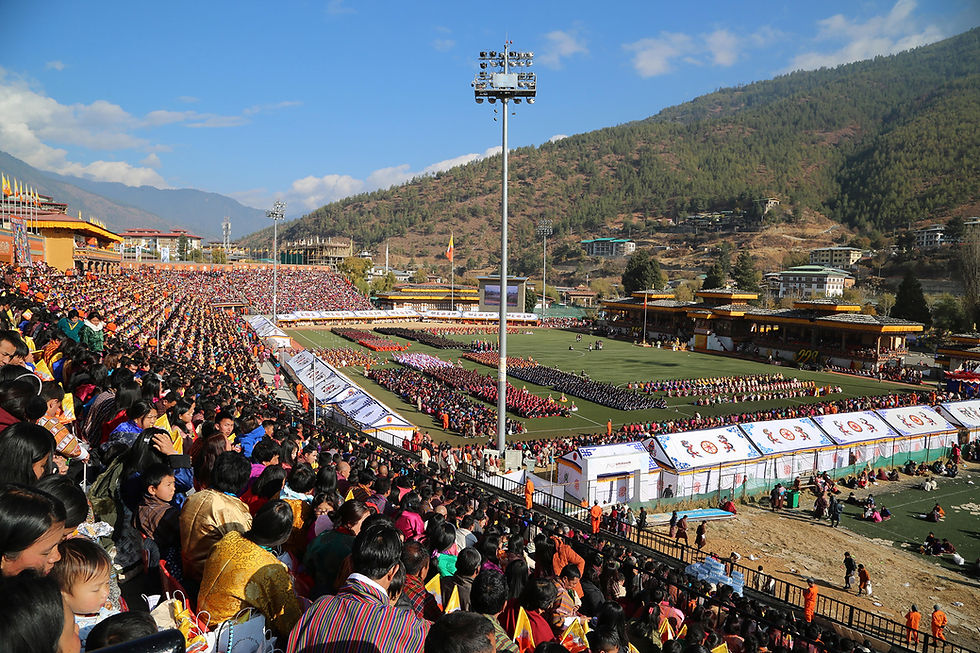The Pomp and Ceremony of Bhutan’s Punakha Warrior Festival
- Bhutan Himalaya

- Feb 6, 2019
- 4 min read
Updated: Sep 6, 2019
At the ancient celebration of Bhutan's Pazaap Warriors, a blend of spiritual tradition and martial history reveal the men who protect the kingdom's holiest relic.
by KARMA DORJI
FEB 15, 2019

Burly and forbidding at first, the warriors are suddenly all smiles, showing teeth stained red by beetlejuice. Won over by promises of hand-delivered photographs, they line up for a group photograph.
We are inside a massive walled fortress the Bhutanese people call a dzong, in Bhutan’s old capital, Punakha. Like their ancient forebears, Bhutan's present-day Pazaap warriors wear heavy spiked brass helmets with protective coverlets that run down the sides and backs of their heads. They carry lightweight shields of woven cane with an outer covering of tough animal hide. Their scarlet knee-length ghos are made from a heavy material of yak hair and wool. Wrapped around their shoulders and their necks are rough lengths of raw silk that, used properly, can stop a full frontal blow from a long sword. And yes, they’re wearing swords; swords over two-feet long swinging swashbuckler-style from their waists.

Later, leaving me with instructions to deliver their photographs when they’re ready, the warriors hurry down the shadowy passages on either side of the fortress. They are the main event at the annual Pageant of Warriors festival, a highlight of one of the hand-selected Signature Journeys we offer each year.
As winter releases its grip on the countryside, and purple jacaranda flowers bloom on the trees outside the fortress walls, the courtyards of the grand old building come alive in a riot of sounds and colors, a medieval celebration recounting the kingdom’s proud history.

Sacred Tooth
The story concerns a religious relic called the kharsapani, a tooth-size miracle statue representing Avalokiteshvara, the Bodhisattva of Compassion. Brought from Tibet by Shabdrung Ngawang Namgyel, the 17th century hierarch of the Drukpa or "Dragon" school of Buddhism who later unified Bhutan, the relic sparked a series of military conflicts with Tibetan forces over its possession. Enter the Pazaap warriors who were sworn by the Shabdrung — a term of reverence that means “at whose feet we kneel” — as the relic’s designated defenders.

Each time the pazaaps drove back the Tibetan troops, they returned with reinforcements. The battles for the tooth relic grew increasingly more relentless until, with no end in sight, the Shabdrung and the pazaaps devised a clever plan to end the hostilities.
During a break in fighting, they formed an elaborate procession of monks and warriors from the fortress to the banks of the Mochu river, which flows beside the dzong, and pretended to throw the holy object in the water. Seeing this from the other side of the river, the Tibetans became convinced that the relic was lost for good, so they stopped fighting and went back to Tibet. In reality, the relic was locked safely away in one of the high towers of the dzong, where it remains to this day. In time, it became one of Bhutan's most fiercely guarded national treasures.

A Martial Celebration
A sudden blast of religious music — drums, long horns, reedy pipes and clashing hand-held cymbals — announces the start of the day's festival. In an outer courtyard of the building the grand procession weaves its way into the dzong. In the grand procession are proud commanders with gleaming brass helmets wearing flashy silks and brocades and riding colorful festooned horses led by retinues of ceremonial monks.

A flash of yellow monastic robes and a gleam reflected from round-rimmed glasses alerts us to the arrival of one of Bhutan’s highest religious figure, His Holiness the Je Khenpo, chief arbiter of all things Buddhism. With the arrival of the chief guest the main court inside the dzong fills quickly with vibrant festival-goers in their best and brightest clothes. Among the audience are the inhabitants of all the neighboring valleys of Punakha, state guests, high officials, ministers and members of the kingdom's revered royal family. After the dignitaries take their seats in the upper viewing area, the festival kicks into high gear.

The Festival
A sudden explosion of fireworks accompanied by blood-curdling shouts, whoops and whistles announcing the entrance of our friends, the Pazaaps. Blades slice the air and shields rise to meet them. Faces contort fiercely, bodies turn and whirl. Drums beat, and feet leap, in a strenuous effortless-seeming ballet telling the story of the brave and historic encounters of warriors past.

Suddenly, a plaintive cry, followed by the music of reedy pipes. The yellow-robed figure of the Je Khenpo rises, followed by his retinue of monks and ceremonial standard bearers. His Holiness leads the procession as it snakes its way out of the courtyard and down the stairs to the banks of the river. Bhutan's spiritual leader throws something round and shiny in the river (I’m told it’s an orange symbolizing the historic deflection we described earlier).

Watching the final episode of one of Bhutan’s many colorful living legends, I am struck by the fact that despite the explosions, in spite of the fierce dances, the leaping, the jousting and the vigorous crossing of swords, the event seems to be about restoring peace.
Ultimately, it seems to be not so much about the prowess of the Pazaaps as about skillfully maneuvering an end to fighting, something we need more of in the world today.
~

Like this article? Get similar features & travel information sent straight to your inbox with the Bhutan Himalaya Newsletter






Comments